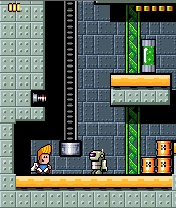
Super Mario Bros on the original NES, as fantastic a game as it was, is one of the finest examples of how to punish a player to the extreme. The game is essentially a long line of unpleasant surprises that you need to memorize in order to make it to the end of each level.
The problem is that learning this sequence is a process of long and drawn out trial and error which often sees you screaming strings of expletives previously thought impossible in the English language or throwing the controller to the ground and stamping on it repeatedly. Or, more usually, both.
Of course, Super Mario Bros is redeemed by its charm, knowing design and sense of fun, all of which encourage you to progress through to the end. Unfortunately, Captain Comet, a platformer of the Mario ilk, shares none of these characteristics and is instead the single most frustrating thing you can do with your thumbs outside of sewing invisible buttons onto a shirt whilst wearing boxing gloves and sitting in the back seat of a tractor, going down a very bumpy road.
The game is as simple an example of the platform genre as you could conceive. Certainly, all the component parts are in place. The controls are simple yet responsive: '4' and '6' move you left and right, and '2' is jump; pressing the '5' key fires your laser gun, while '0' lays a bomb. Throw in a cutesy character, Captain Comet, and hordes of evil robots to dispatch in a hazard-ridden platform playground and you should end up with a decent, if unimaginative, platformer.
The premise, as you might expect, has you navigating your surroundings using the bombs and blasting away the robots using your laser gun. You only get a limited number of bombs and lasers so you need to keep a sharp eye on every nook and cranny for pick-ups.
The problem with all of the above seemingly straightforward elements is that Captain Comet's levels are peppered with invisible hazards that only make themselves known after you have met your end at their hand. Laser cannons fire at random, blind jumps (of which there are many and are always enforced by the game's linear route) cause you to land on spikes you could not possibly have known were there, and moving scenery crushes you in the most unexpected places.
For instance, to even progress past the first stage you'll need to, through a laborious and frustrating process of trial and error, restart the level an inordinate number of times and play through sections repeatedly, which in our book is an inexcusable flaw.
There are positives. The game looks quite nice (if a little samey throughout), the backgrounds scroll in parallax (as if detached from the foreground), giving the impression of depth, while the bequiffed protagonist is also loveable enough.
But winning presentation and some decent visuals are not nearly enough to save this title from some of the worst level design ever seen in a platforming game. Essentially, you should only play this if you enjoy tedium, relish the idea of having your patience tried to its limit and have a powerful thirst for games completely devoid of imagination, flair and fun.
Captain Comet Review
